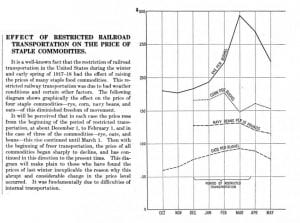Beginning in December 1917, and continuing through late February 1918, New York Harbor, a key hub of logistical support for the Allied war effort on the Western Front during World War I, was paralyzed by a seemingly unending series of ice storms and blizzards. The unique design of the harbor, and the problematic interface between rail traffic and the loading of goods on board merchant vessels through barges and lighters combined into a meteorological and environmental disaster until the storm front finally ceased. Military-environmental analysis of this event provides a new understanding of the war effort in the United States.
This is an abstract for an article appearing in the online journal Arcadia. To read the full text of this article, click here.

Related: Terms of Disaster collection
Gerard J. Fitzgerald, Ph.D., is a visiting scholar in the Department of History and Art History at George Mason University. This essay comes from his larger book project, The Nature of War: An Environmental History of Industrialization in the United States During World War I, 1898–1920. He largely researched this article at the Linda Hall Library in Kansas City, Missouri, where he was a fellow in 2018. He recently published “The Chemist’s War: Edgewood Arsenal, the First World War, and the Birth of a Militarized Environment,” in Environmental Histories of the First World War, edited by Richard P. Tucker et al. (New York: Cambridge University Press, 2018).
* * *
The Teach311 + COVID-19 Collective began in 2011 as a joint project of the Forum for the History of Science in Asia and the Society for the History of Technology Asia Network and is currently expanded in collaboration with the Max Planck Institute for the History of Science(Artifacts, Action, Knowledge) and Nanyang Technological University-Singapore.
![[Teach311 + COVID-19] Collective](https://blogs.ntu.edu.sg/teach311/files/2020/04/Banner.jpg)